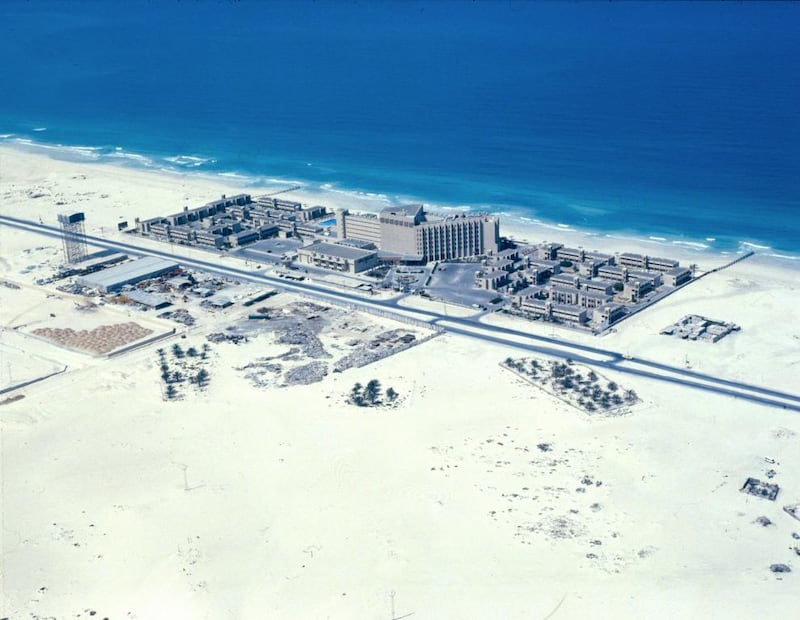In the 1960s, as the country’s oil industry was taking off with the discovery of offshore reserves, the local hospitality industry was just being born.
During that time, a US engineering and construction firm called Chicago Bridge and Iron built oil tankers, or kazans, on a patch of beach in Dubai, which popularly came to be known as Chicago Beach.
It would not be until 1977, six years after the formation of the country, that Dubai got its first resort residence with the 615-room Chicago Beach Hotel. Old pictures of the hotel show a big box structure surrounded by pools on the beach and at the rear, scrubby desert land stretching into the distance.
Today, the Dubai’s six-star hotel Burj Al Arab and Jumeirah Beach Hotel stands where the old structure used to be. The actual site of the old hotel now also houses the Wild Wadi Water Park.
“It got visitors from Scandinavia, Germany and the United Kingdom, apart from the business visitors from the Arabian Gulf such as Saudi Arabia and Kuwait,” says Gerald Lawless, the president and group chief executive of Jumeirah Group. The occupancy then was on average 70 per cent.
First set up as utility buildings focused on business travellers, hotels in the Emirates have come a long way in 42 years to where now they set trends in luxury and are a part of the country's brand attraction for tourists.
The Abu Dhabi National Hotels Company was set up in 1975 and three years later acquired Hilton International Abu Dhabi, Hilton International Al Ain and Ramada Abu Dhabi Airport Hotel.
One of them, the 100-room Hilton International Al Ain, was built in 1971 and received royalty and dignitaries besides hosting international conferences as the UAE gained prominence in business and international affairs. The 186-room Hilton International Abu Dhabi, built in 1973, also hosted conferences while the 200-room Ramada Abu Dhabi Airport Hotel was set up in 1977 and fashioned after a country club. Abu Dhabi InterContinental, Hotel Meridien Abu Dhabi and Abu Dhabi Sheraton Hotel – set up by 1979 – were receiving business guests.
In the early days of Dubai, further towards the creek side where business was concentrated due to its proximity to the airport, Hyatt Regency Dubai, InterContinental and Sheraton hosted many of the business guests, including the crews of several airlines.
“There was hardly any tourism business then; most of our business was corporate generated from banks, trading companies and airline crew,” says Habib Khan, who joined the Hyatt Regency Dubai in 1980 and is now the general manager and chief executive at Arabian Courtyard Hotel and Spa in Dubai.
Today, the breakdown of guests in Dubai is about 70 per cent of leisure tourists and 30 per cent business, says Rashid Aboobacker, a senior consultant at Tri Hospitality Consulting.
“With the exception of Abu Dhabi, where tourism has been primarily business-driven, all other emirates report a higher proportion of leisure demand,” Mr Aboobacker says.
The newer top hotels in the UAE, as measured by online bookings websites, sport their sun, sand and sea attractions with a splash of traditional Islamic and Arabic architecture inspired by domes, spires, wind towers and covered souqs.
From the Thai hotel chain’s Desert Islands Resort & Spa by Anantara and the seven-star Emirates Palace Hotel here in the capital to Le Méridien Mina Seyahi Beach Resort and Al Maha Desert Resort and Spa in Dubai, the hotel landscape of the country is now geared towards leisure as well as business travellers.
The Jumeirah Group is behind the famous Burj Al Arab and hotel complex Madinat Jumeirah, which has two boutique hotels, Al Qasr and Mina A’Salam, 29 summer houses in Dar Al Masyaf and seven Malakiya Villas, besides other properties in Dubai and Abu Dhabi.
“The products are what make Dubai the greatest tourism destination,” Mr Lawless says. “But customers are becoming more discerning and looking for more individual experience and hotels will continue to evolve, especially for more sophisticated tourists in terms of their taste for culture.”
While international hotel chains were the first to cater to visitors in the early days of the country, over the years local hospitality companies such as Jumeirah, Emaar and Rotana Hotel Management Corporation have developed independent products. Jumeirah now owns and runs hotels in Baku, Frankfurt, Istanbul, London, the Maldives, Mallorca, Rome and Shanghai besides Dubai and Abu Dhabi under its brand name.
Emaar Properties, launched in 1997, has total hospitality assets valued at US$1 billion and owns and manages hotels, serviced residences and golf resorts among other products.
The architecture of the hotels have changed as well. Back in 1979, when the architect Steven Miller first came to this country, high-rise meant anything above three stories.
“Then Abu Dhabi and Dubai meant nothing, everything was in Sharjah with four and five-storey buildings,” says Mr Miller, now the senior vice president of business development at the Dubai-based Indian construction firm Shapoorji Pallonji International.
When he returned to Dubai for a longer term in 2005, he recalls having noticed few budget hotels.
“From that point on, the market has matured,” Mr Miller says.
“Now, there is something for everybody. This is now a shopping and resort environment that also handles [meetings, incentives, conference and exhibitions] visitors”
ssahoo@thenational.ae





